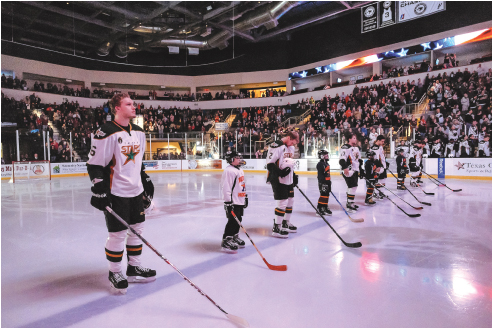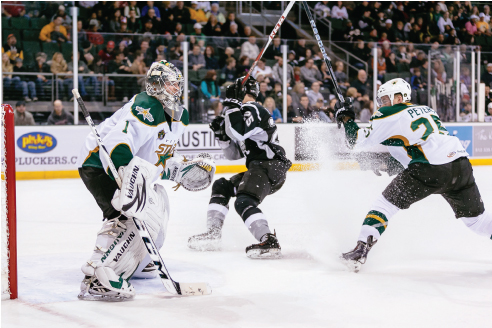Skating South and Finding Fans

Lower the shoulder, lunge the body forward, and boom. Bodies collide and crackle. The observant crowd erupts in applause that borders on celebration.
In the South, this is a scene that plays on repeat at football fields every weekend in the fall. It’s also why Central Texans seem to be gravitating to another sport that focuses on physicality and boasts athleticism.
Granted, a hockey rink resembles nothing of the gridiron, but watch closely enough and the principles are the same. Brute force and quick-cutting agility are equal parts necessary to survive on the ice. In the span of seconds, hockey players can be stiff-arming an opponent into the glass then cutting away in a full-out, breakaway sprint, chasing the slippery puck toward the goal.
 Hockey is stamina and strength, mind over matter.
Hockey is stamina and strength, mind over matter.
“Hockey translates and is understood by sports fans and specifically football fans,” said Rick McLauglin, president of the Texas Stars Hockey Club, which competes in Cedar Park, Texas. “Fans like hockey because it’s fast-paced, hard-hitting—they like the action.”
The Texas Stars are the minor league affiliate of the Dallas Stars, which relocated to Texas from Minnesota in 1993. McLaughlin was with the Stars’ front office during that transition south, and he said the team was able to penetrate a new market and educate a growing fan base, in part, through youth hockey. The Stars adhere their name and lend resources to local programs that facilitate hands-on coaching and instruction, and by growing hockey development among juniors, they’re also planting little seeds among families that might become season ticket holders.
 It was a strategy that worked in Dallas—of course, the Stars’ 1999 Stanley Cup championship helped—and is being duplicated in Central Texas. The Texas Stars have instituted the Texas Junior Stars in partnership with the folks at Chaparral Ice. “We want the kids to learn the game and have fun,” McLaughlin said.
It was a strategy that worked in Dallas—of course, the Stars’ 1999 Stanley Cup championship helped—and is being duplicated in Central Texas. The Texas Stars have instituted the Texas Junior Stars in partnership with the folks at Chaparral Ice. “We want the kids to learn the game and have fun,” McLaughlin said.
It’s an integral period of instruction and education. For a sport that features such focused precision and all-out aggression, every detail matters. Even today, as the Texas Stars are charging to another American Hockey League playoff run, habits and rituals that were instituted during youth play define these professionals as they prepare for a grueling 60 minutes on the ice.
For a home game at the Cedar Park Center, the team is required to arrive two hours before face-off, but it’s not unusual to see these gentlemen strolling in almost three hours early. They’ll sip a cup of coffee in the team lounge, fiddle with their hockey sticks, and generally ease into the rhythm of the game. But don’t be fooled by the simplicity of their strides or the relaxation of their banter. Everything is timed to the minute, from when they step into their first warm-up lunge to when they pull on their pads.
“It’s the way they start them out as kids. Even when they’re little, young kids, they develop these routines, and they just stick with them,” said Texas Stars athletic trainer Jason Wallace.
While it’s hard to see under their baggy sweaters and bulky padding, hockey players are hard-wired athletes, chiseled physiques of fast-twitch, flexible muscle fibers. Teams generally consist of four lines, which substitute in and out about every minute. In a game that consists of three, 20-minute periods, they play bursts that are nothing short of all-out sprints, with a few jaw-rattling body checks thrown in for good measure.
“If you still have gas after a minute, you haven’t been working very hard,” said Francis Wathier, a ninth-year professional and one of the Stars’ assistant captains.
The philosophy of Stars’ coach Willie Desjardins is tempo, tempo, and more tempo. It’s a fast-paced style that’s designed to wear down opponents. And, since the NHL lockout in 2004–05, it’s a philosophy that’s being adopted by most teams. “The biggest part of the game is your confidence level. If you’re going to do something and you’re not sure, you can’t go 100 percent,” Dejardins said. “But if you’re confident, you can execute at the highest level.”
 For hockey athletes, their offseason is just as important as their season. After a season ends, they’ll go through a short rest and recovery period then launch into their offseason conditioning, which consists of foundational phases like strength, flexibility and power.
For hockey athletes, their offseason is just as important as their season. After a season ends, they’ll go through a short rest and recovery period then launch into their offseason conditioning, which consists of foundational phases like strength, flexibility and power.
Wathier, for instance, lives on a farm in his native Canada, so in addition to his plyometrics and Olympic lifting, he’s also working the tractor, feeding horses, and heaving hay. Mike Hedden, a left wing out of Ontario, works at a buddy’s training facility and utilizes a skating treadmill to maintain his cardio fitness.
“It’s made of synthetic plastic, and you’re strapped into a harness,” Hedden explained. “You can drift back and do sprints up. I do that all summer. Otherwise, I like CrossFit-style circuit training that is quick, 30-second bursts and 20 seconds of rest before the next exercise.
“Training has just been imbedded in me over the years…After games, you’re absolutely exhausted. You can’t even move after the game.”
It’s this level of effort—this dedication to their team and practice—that is allowing hockey to win over fans in Central Texas. Though still most popular in Canada, the northern United States, and Europe, hockey is migrating south. The Texas Stars average more than 5,000 fans for their games at the Cedar Park Center.
“We have a lot of legs,” Wathier said. “If you’re able to play with a high skill level, even when you’re tired, you’re going to beat a lot of teams.”






